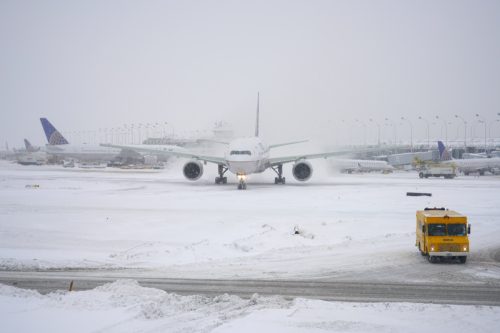“Arctic Blast” Could Send Temps Plummeting—How Cold It’ll Be in Your Region

Winter is here, and it’s not wasting any time in 2024. On top of three recent storms—one of which is set to hit the Plains and the Midwest today—millions of Americans are now gearing up for the first “arctic blast” of cold this season. According to USA Today, 88 percent of the contiguous U.S. is expected to see temperatures drop below freezing by Monday. Read on to find out how cold it’ll be in your region.
RELATED: “Bomb Cyclone” Could Bring 2 Feet of Snow to These Areas, Forecasters Predict.
Exceptionally frigid temperatures are on the docket for the Northwest and Central Plains.

According to The Weather Channel, the cold air outbreak could smash records across the U.S. Meteorologists predict that this blast will come in two rounds, with the first hitting the northern Rockies, the Northwest, and the Central Plains from today into tomorrow.
The records for the coldest calendar day could be achieved in Wyoming and Montana. In Montana, specifically, experts say that temperatures could go as low as minus 40 degrees Fahrenheit, while in the Northern Plains, temperatures could get down to the minus 50s at times.
Also in these areas, The Weather Channel warns about strong winds that will come along with the cold air. When the two are combined, it can lead to dangerous wind chills.
RELATED: A “Polar Vortex” Is Expected to Hit the U.S. Soon—Here’s What to Know.
Parts of the Southern Plains and the Midwest could have their lowest temperatures in years.

Following the first round, frigid temperatures may make their way to the Southern Plains and the Midwest. This weekend, temperatures may drop well below freezing for a stretch.
According to The Weather Channel, temperatures could dip into the minus 20s in states as far south as Iowa and Nebraska. In the Southern Plains, namely parts of the Texas Panhandle and Oklahoma, below-zero temperatures are also expected.
The Weather Channel notes that O’Hare Airport in Chicago may see the lowest temperatures since Jan. 2019, dipping into the minus teens. In addition, Oklahoma City might experience the lowest temperatures since the Feb. 2021 cold outbreak. However, the outlet notes that this year’s first arctic blast isn’t expected to be as intense as those previous events.
Those in the South should prepare for below-freezing temps.

The South will deal with the arctic blast too, meteorologists say. On the northern Gulf Coast, spanning from East Texas to North Florida, The Weather Channel says temperatures may be in the 20s during the coldest days. Some weather models show that nearly the entire state of Texas could see below-freezing temperatures by Monday and Tuesday of next week, USA Today reports.
Wind chills are a concern in the South as well due to the combination of cold air and strong winds, per The Weather Channel.
RELATED: How New “Extreme” Thunderstorms and Wind Are Increasing—And Affecting Where You Live.
The East will see colder temperatures and a storm.

By the start of next week, the lowest temperatures of the winter are predicted to hit the Atlantic Coast north of Florida, AccuWeather reports.
Complicating matters, the cold is also going to aid in setting up a storm track “that favors snow and ice” in the South and the East, the outlet says.
While it’s going to hit the South first, AccuWeather warns that wintry precipitation could then move north to Virginia, Maryland, Delaware, Pennsylvania, New Jersey, New York, and New England next Tuesday into Wednesday.
RELATED: For more up-to-date information, sign up for our daily newsletter.